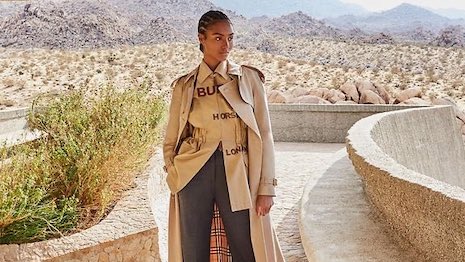- About
- Subscribe Now
- New York,
June 18, 2020

 Burberry spring looks from Farfetch. Image credit: Farfetch
Burberry spring looks from Farfetch. Image credit: Farfetch
A new survey from online retailer Farfetch on the environmental benefits of buying pre-owned fashion found that 38 percent of respondents said more than half of their wardrobe was made up of pre-owned items.
When broken by country, the number rose to 51 percent for U.S. respondents, 42 percent for U.K. and only 21 percent for China. The survey was fielded in these three markets to 3,000 consumers – 1,000 in each – who have bought at least one pre-owned item in the last year.
“Existing data shows that luxury resale represents a $24 billion market that is growing four times faster than the primary luxury market, partly due to consumer interest in sustainable fashion, but data on resale’s environmental impact is limited,” said Thomas Berry, director of sustainable business at London-based Farfetch in a statement.
Old is new
On average, respondents in these markets bought eight pre-owned items in 2019.
Also, for 52 percent of pre-owned items, buyers were actively searching for pre-owned.
Sixty percent of pre-owned buyers are buying in-store, on average – 74 percent for the United States, 62 percent for the United Kingdom and 42 percent for China.
Forty percent said they were buying pre-owned items online, with 26 percent for the U.S., 38 percent for the U.K. and 58 percent for China.
Forty-nine percent of pre-owned buyers in these markets said they were buying high-street brands, 35 percent premium brands and 16 percent luxury brands.
The Farfetch survey found that U.S. and U.K. pre-owned buyers purchase more clothing, while in China they buy more footwear and jewelry and watches.
What were the top four reasons for buying pre-owned? Forty-two percent cited better price, 30 percent for rare items, 13 percent cited environmental reasons and 11 percent highlighted good past experience.
Overall, survey respondents in China were more likely to buy more pre-owned items due to item rarity, while in the U.S. and the U.K. they are more driven by a better price.
China topped the findings for average spend per pre-owned item at $88, followed by the U.S. at $59 and the U.K. at $47.
Interestingly, 57 percent overall of pre-owned fashion purchases prevented consumers from buying something new, with the U.S. and U.K. leading at 65 percent compared to China’s 41 percent.
Finally, the survey found that, on average, one pre-owned purchase saves 2.2 pounds (1kg) of waste, 3,040 liters of water and 48.4 pounds (22kg) of carbon dioxide.
Replace and displace
Farfetch commissioned the study in partnership with QSA, ICARO and London Waste and Recycling Board to focus on two questions.
First, does the purchase of a pre-owned fashion item replace the purchase of a new item, therefore reducing the demand for additional items that require new resources?
Next, what is the average environmental impact such as carbon, water and waste for fashion items that can be applied with the displacement rate to give an indication of the environmental savings when someone purchases a pre-owned item?
This research is part of the retailer’s Positively Farfetch sustainability effort launched last year.
“With this research, we want to support our partners and more broadly the luxury industry, in helping to drive positive change,” said Giorgio Belloli, chief commercial and sustainability officer of Farfetch, in a statement.
“In addition to the core business initiatives we are launching within the sustainability space, we aim to become a source for data and tools in the circular space to drive this positive change,” he said. “This marks the first step into that direction.”
Farfetch has created a fashion footprint tool for consumers to understand how their pre-owned and conscious fashion choices can affect the environment.
Available on Farfetch.com, the tool lets consumers, when deciding a purchase, to consider which materials can reduce the environmental impact of their purchase, and to see the environmental savings of incorporating pre-owned purchases into their wardrobes.
“Farfetch has been selling a curated selection of pre-owned and vintage fashion online since 2010, and in 2019 launched two services offering customers the ability to sell or donate their pre-owned items,” Mr. Berry said.
“We wanted to better understand the environmental benefits of all these models as we continue to focus on projects to enable us and our partners to reduce environmental impacts,” he said.
Share your thoughts. Click here